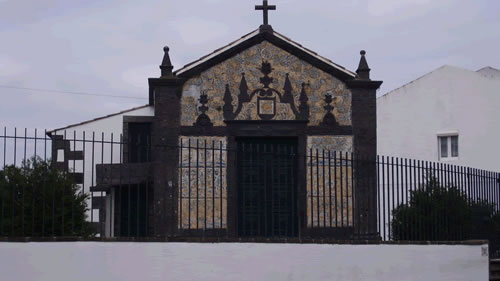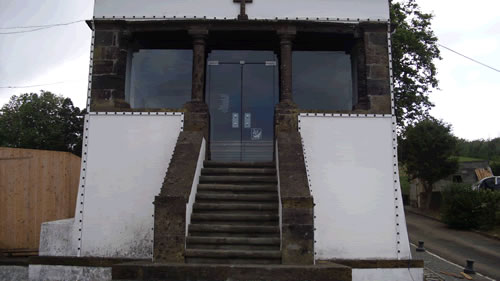
Ceramic is one of the oldest materials used by man, becoming for centuries a material of predilection for domestic use, becoming later a material of choice in architectural coating, becoming popular in the use of the tile, either on the floor or on the ceiling, and later on the walls.
In the Iberian Peninsula, tile art became popular in Andalusia from the 13th century, thanks to the Arabs, who were adept at this technique of ornamentation. In Portugal, tile was used between the late 15th / first half of the 16th century, although preserved and adapted, arising from this adaptation of the Hispano-Moorish style.
In the Azores, between the fifteenth and eighteenth centuries, the tile was imported from different national and international zones, but only from the 19th century began to produce tiles on the island of São Miguel, thanks to the foundation of several ceramic factories, namely In the municipality of Lagoa, becoming a reference in the production of ceramics.
It is worth mentioning the Fábrica Cerâmica Vieira, ex-libbris of the city of Lagoa, founded in 1862, in which its founders were: Bernardino da Silva, native of Coimbrões, parish of Santa Marinha, municipality of Vila Nova de Gaia; Manuel Leite Pereira, born in Peso da Régua; Tomáz d'Avila Boim, native of the island of Pico; And Manuel Joaquim d'Amaral, native of Povoação. This factory is one of the few industrial and artistic assets that have survived over five family generations, and is currently the only glazed ceramic factory in the Azores Archipelago, which manufactures all of its dishes in its facilities. Its production continues to be handmade, from the molding on the old potter's wheel to manual painting, with a very characteristic decoration where the blue and white predominates, being commonly known as "Louça da Lagoa".
In the religious patrimony of the parish of Santa Cruz, there are two magnificent buildings of religious character - hermitages - with examples of tiles.
In order to elevate the Lagoa as a ceramic earth, and seeing that behind the altarpiece of the main altar of this church are some tiles covering the footer, suspecting that the tiles are from left over from the Hermitage of Our Lady of the Cape, as well as a few examples of the hydraulic tijoleira that covers the collateral Chapel of the Blessed Sacrament, it was strictly necessary to make a reference.
In addition to the ceramic tiles, and in addition to the fact that there is equipment ceramics, since this space is seen in most churches as an extension of the sacristy, to storage or support the liturgical ceremonies, was created the Ceramic and Tiling Core where some twenty-five pieces are glimpsed.
+ HERMITAGE OF OUR LADY OF THE CABLE

Hermitage located in the parish of Santa Cruz, built by Father João Alves da Cruz in 1675, on the leave obtained from Bishop D. Fr. Lourenço de Castro on October 6, 1674. The invocation of this hermitage to Our Lady of the Cape is due to the Fact that its founder has a great devotion to Our Lady of the Cape of Espichel, in Extremadura. Also invoked in this city under the title of Our Lady of the Star, due to the day chosen by its founder for her party to be the 2nd of February dedicated to Our Lady of the Star. The philharmonic band of this parish "Estrela d'Alva", founded in 1887, chose this one like protector.
This hermitage, one of the ex libris of the county of Lagoa, is covered in the facade by polychrome tiles dated of 1678, with several configurations. At the top of the door is a central cardboard bearing the following inscription:
NOSA SA
DO CABO FACTA
APA … E IOANE AL
… RVCE
ANNO
1675
Interior of a single nave covered, also, by polychrome tiles. It presents a very rich altar in carving.
The Ermida is classified as Property of Public Interest.
+ ERMIDA DE NOSSA SENHORA DOS REMÉDIOS

Ermida located in the place of the Remedies, an integral part of the parish of Santa Cruz, built in the place where before there was a corral and sheep, between the end of the fifteenth century and beginning of the sixteenth century, founded by Pêro Velho, nephew of the discoverer of the Azores Gonçalo Velho, and his wife Catarina Afonso, under devotion to Our Lady of Remedies. Unique hermitage in the island of São Miguel, for presenting a façade that escapes the traditional and a covered porch on the sides. It presents in the interior an altar front covered with tiles from the Hermitage of the Mother of God, located in the parish of São Pedro (Ponta Delgada), replacing the original Hispano-Moorish tile altarpiece, the oldest of the Azores. Retired in the first half of the 20th century by Luís Bernardo Leite de Ataíde, for being damaged, and was taken to the Carlos Machado Museum, where he is on display.
The Hermitage of Our Lady of Remedies was from its origin until 1958 a private property, and in the late twentieth century donated to the Parish of Santa Cruz by Dr. Leonardo de Moraes Motta, becoming public domain.
Like the Hermitage of Our Lady of the Cape, this Hermitage has been classified as Property of Public Interest since 1980.









